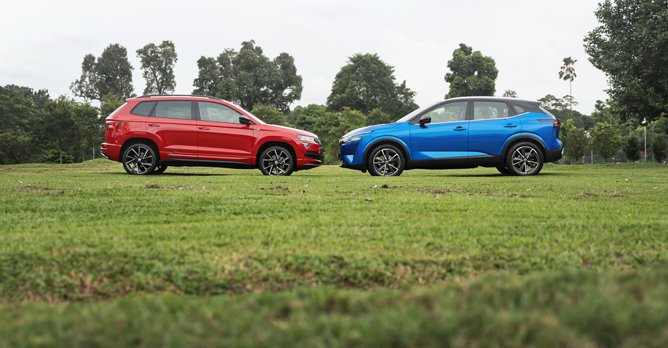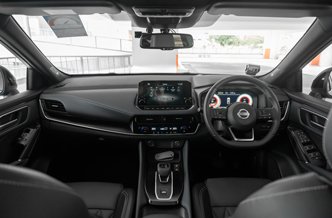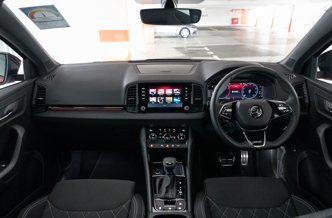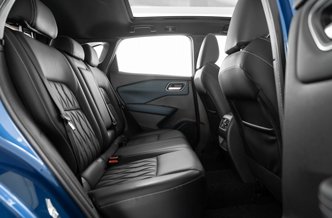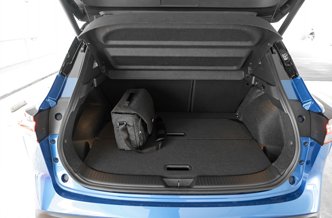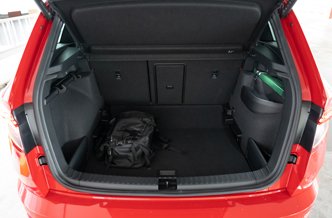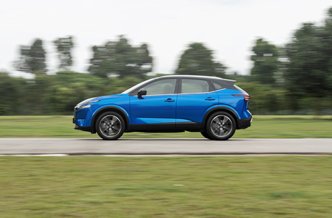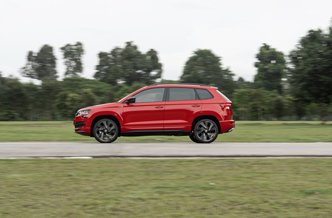Nissan Qashqai 1.3 Turbo Prestige (A) vs Skoda Karoq 1.5 TFSI Sportline
31 Aug 2022|18,906 views
Nissan Qashqai
Comfier seats
More upmarket styling and interior
Cushier and quieter ride
Less expensive
Skoda Karoq
Snazzier cockpit
Has the edge in practicality
Quicker and nimbler
More expensive
When the Skoda Karoq was launched, it was lauded for its focus on usability and flexibility. Coupled with numerous safety features and a punchy turbocharged engine, the Karoq ticks a lot of boxes for most buyers.
Recently facelifted, the Karoq now looks sharper than before, and its interior has received several improvements, too. These upgrades are timely, for the Karoq now has another rival to contend with: The all new Nissan Qashqai.
The latest iteration of this popular crossover is roomier than its predecessor, comes with a more high-tech cockpit, and packs a more powerful drivetrain.
Will the Karoq outsmart its competitor? Or will the Qashqai have the edge in this shootout?
Walkaround
Skoda isn't exactly known for its exterior styling, but the Karoq certainly looks unique. Its design is better than the pre-facelift model's, with a wider grille and slimmer head lights.
There are new air curtains in the front apron, and though we can't see it, a covered underbody. The latter should improve aerodynamics and make for a quieter cabin.
The Karoq's stance could have been improved, though. Due to the generous wheel arches, its 18-inch wheels look undersized.
This is not an issue in the Qashqai, which is immediately more attractive. The long headlamps, V-shaped grille and angular front bumper make it look fresh and dynamic.
Crisp shoulder lines and sharp taillights, which echo the design of the head lights, ensure that the overall styling remains consistent.
Driver's environments
The Karoq may not look as good as the Qashqai outside, but the snazzy cockpit makes up for this.
Unlike the preceding model which has an analogue cluster, the current one has the digital virtual cockpit, with several layout options to choose from. There are multiple colour options for the mood lighting as well, compared to just one for the Qashqai.
Meanwhile, sporty touches include front seats with fixed headrests, alloy pedals and a dimpled finish for the steering wheel. However, the controls on the latter are not as user-friendly as the ones in the Qashqai, which has larger buttons.
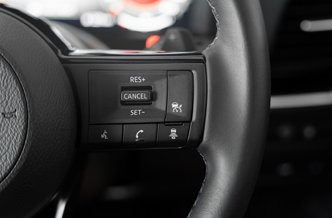 | 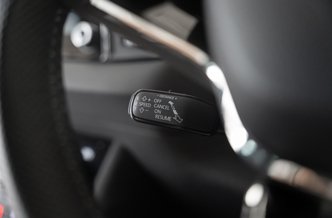 |
In terms of infotainment, the Qashqai's display is larger than the Karoq's, though the Skoda's graphics are nicer. Both systems are easy to use and have the convenience of wireless Apple CarPlay, too.
That said, the Karoq is more practical than the Qashqai. Its door pockets are larger, there's a multi-function cup holder, and an additional storage bin atop the dashboard.
Rear accommodations
Although the Qashqai is the larger of the two crossovers and has a longer wheelbase, the Karoq's backseat is surprisingly more spacious.
It offers more legroom and foot space, and easier ingress and egress, too, as the lower hip point makes this crossover feel more hatchback-like. The door bins here are also larger.
The rear seats, which Skoda calls VarioFlex, can be individually slid and reclined, so you can vary the passenger space and/or boot capacity.
Now, although the Qashqai isn't as roomy and has smaller storage points, it does offer occupants a pair of handy USB ports. For flexibility, one USB-A and one USB-C port are provided.
In comparison, the Karoq's single 12-volt outlet means that in addition to charging cables, one must also have an adapter on hand.
With regard to boot space, the Qashqai has 504 litres with the rear seats in place, and 1,593 litres once the backrests are folded. It also has a variable floor height for added flexibility.
However, when it comes to usefulness, the Karoq is in a league of its own. The boot has 521 litres with the rear seats up and 1,605 litres when they're folded. Remove the rear seats and capacity grows to a van-like 1,810 litres.
Turbocharged characters
 | 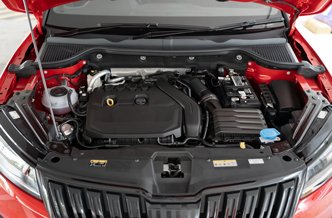 |
Beneath the Qashqai's bonnet is a turbocharged 1.3-litre four-cylinder capable of 156bhp and 270Nm. Paired to a CVT, the Qashqai does the century sprint in 9.2 seconds.
Though it has less power, the Karoq is actually quicker. Its turbocharged 1.5-litre in-line-four delivers 148hp and 250Nm, and with a seven-speed dual-clutch gearbox, gets the Karoq from rest to 100km/h in 8.8 seconds.
Interestingly, however, the Karoq is not as responsive as the Qashqai off the line, despite the torque arriving at lower revs. And the Qashqai not only feels nippier - it is more refined, too.
On the go, the Qashqai is quieter and feels more seamless, thanks to the unobtrusive CVT. The ride quality undoubtedly helps, for the dampers are also well-tuned.
The Karoq, though, caters to keener drivers. With sports seats to hold you in place and a quick-shifting transmission, the manual override is more satisfying to use here than in the Qashqai.
Though not as pliant as the Qashqai, the Karoq has the advantage in handling, as it feels nimbler and is more willing to be chucked around. Between the two, drivers who are new to crossovers will find the Karoq easier to adapt to.
Decision-making
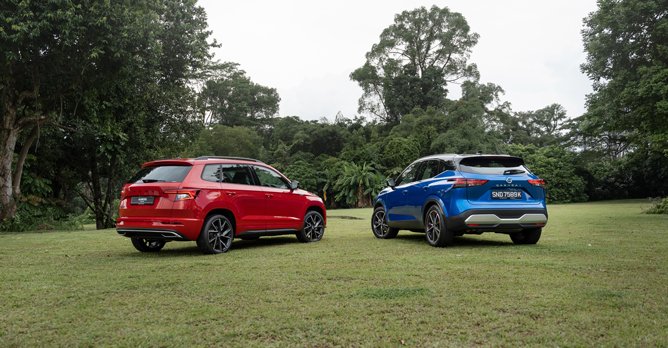
If you like to drive, you'll gravitate towards the Karoq Sportline. Its performance has more verve compared to the Qashqai Prestige, and it also has the edge in flexibility.
However, I'm still not down with its exterior design, and the car doesn't feel as responsive despite being quicker than the Qashqai.
Although the Qashqai is less practical and isn't as nimble as the Karoq, it's hard not to be swayed by its comfort and refinement. Given the deteriorating road and traffic conditions, a crossover with a smoother drive, a more upmarket cabin and a more compliant ride, is what you need while driving home at the end of the workday.
It's a close match, but the Qashqai is my preference, for its qualities make it even more attractive than the Karoq to live with on a daily basis.
Looking to compare more cars? Check out these other Group Tests
Honda HR-V lines up alongside the Peugeot 3008
Mercedes-Benz CLA180 goes head-to-head with the BMW 216i Gran Coupe
Opel Mokka takes on the Renault Captur
Polestar 2 Long Range Single Motor goes up against the Tesla Model 3
Audi Q5 lines up alongside the Jaguar F-Pace
Nissan Qashqai
Comfier seats
More upmarket styling and interior
Cushier and quieter ride
Less expensive
Skoda Karoq
Snazzier cockpit
Has the edge in practicality
Quicker and nimbler
More expensive
When the Skoda Karoq was launched, it was lauded for its focus on usability and flexibility. Coupled with numerous safety features and a punchy turbocharged engine, the Karoq ticks a lot of boxes for most buyers.
Recently facelifted, the Karoq now looks sharper than before, and its interior has received several improvements, too. These upgrades are timely, for the Karoq now has another rival to contend with: The all new Nissan Qashqai.
The latest iteration of this popular crossover is roomier than its predecessor, comes with a more high-tech cockpit, and packs a more powerful drivetrain.
Will the Karoq outsmart its competitor? Or will the Qashqai have the edge in this shootout?
Walkaround
Skoda isn't exactly known for its exterior styling, but the Karoq certainly looks unique. Its design is better than the pre-facelift model's, with a wider grille and slimmer head lights.
There are new air curtains in the front apron, and though we can't see it, a covered underbody. The latter should improve aerodynamics and make for a quieter cabin.
The Karoq's stance could have been improved, though. Due to the generous wheel arches, its 18-inch wheels look undersized.
This is not an issue in the Qashqai, which is immediately more attractive. The long headlamps, V-shaped grille and angular front bumper make it look fresh and dynamic.
Crisp shoulder lines and sharp taillights, which echo the design of the head lights, ensure that the overall styling remains consistent.
Driver's environments
The Karoq may not look as good as the Qashqai outside, but the snazzy cockpit makes up for this.
Unlike the preceding model which has an analogue cluster, the current one has the digital virtual cockpit, with several layout options to choose from. There are multiple colour options for the mood lighting as well, compared to just one for the Qashqai.
Meanwhile, sporty touches include front seats with fixed headrests, alloy pedals and a dimpled finish for the steering wheel. However, the controls on the latter are not as user-friendly as the ones in the Qashqai, which has larger buttons.
Qashqai's cruise controls (left) on the steering wheel are more intuitive than the Karoq's, which are on this third stalk
The Qashqai's cockpit feels more upmarket compared to the Karoq's. In addition to its digital instrument panel, it has 10.8-inch head-up display, plusher seats upholstered in quilted Nappa leather, and a powered driver's seat. In the Karoq, both front seats are manually adjusted.In terms of infotainment, the Qashqai's display is larger than the Karoq's, though the Skoda's graphics are nicer. Both systems are easy to use and have the convenience of wireless Apple CarPlay, too.
That said, the Karoq is more practical than the Qashqai. Its door pockets are larger, there's a multi-function cup holder, and an additional storage bin atop the dashboard.
Rear accommodations
Although the Qashqai is the larger of the two crossovers and has a longer wheelbase, the Karoq's backseat is surprisingly more spacious.
It offers more legroom and foot space, and easier ingress and egress, too, as the lower hip point makes this crossover feel more hatchback-like. The door bins here are also larger.
The rear seats, which Skoda calls VarioFlex, can be individually slid and reclined, so you can vary the passenger space and/or boot capacity.
Now, although the Qashqai isn't as roomy and has smaller storage points, it does offer occupants a pair of handy USB ports. For flexibility, one USB-A and one USB-C port are provided.
In comparison, the Karoq's single 12-volt outlet means that in addition to charging cables, one must also have an adapter on hand.
With regard to boot space, the Qashqai has 504 litres with the rear seats in place, and 1,593 litres once the backrests are folded. It also has a variable floor height for added flexibility.
However, when it comes to usefulness, the Karoq is in a league of its own. The boot has 521 litres with the rear seats up and 1,605 litres when they're folded. Remove the rear seats and capacity grows to a van-like 1,810 litres.
Turbocharged characters
Qashqai's motor (left) impresses with its quiet demeanour, while the Karoq's engine lends itself well to spirited driving
Both the Qashqai and Karoq have turbocharged powertrains that have comparable performance on paper, but their personalities are quite different.Beneath the Qashqai's bonnet is a turbocharged 1.3-litre four-cylinder capable of 156bhp and 270Nm. Paired to a CVT, the Qashqai does the century sprint in 9.2 seconds.
Though it has less power, the Karoq is actually quicker. Its turbocharged 1.5-litre in-line-four delivers 148hp and 250Nm, and with a seven-speed dual-clutch gearbox, gets the Karoq from rest to 100km/h in 8.8 seconds.
Interestingly, however, the Karoq is not as responsive as the Qashqai off the line, despite the torque arriving at lower revs. And the Qashqai not only feels nippier - it is more refined, too.
On the go, the Qashqai is quieter and feels more seamless, thanks to the unobtrusive CVT. The ride quality undoubtedly helps, for the dampers are also well-tuned.
The Karoq, though, caters to keener drivers. With sports seats to hold you in place and a quick-shifting transmission, the manual override is more satisfying to use here than in the Qashqai.
Though not as pliant as the Qashqai, the Karoq has the advantage in handling, as it feels nimbler and is more willing to be chucked around. Between the two, drivers who are new to crossovers will find the Karoq easier to adapt to.
Decision-making

If you like to drive, you'll gravitate towards the Karoq Sportline. Its performance has more verve compared to the Qashqai Prestige, and it also has the edge in flexibility.
However, I'm still not down with its exterior design, and the car doesn't feel as responsive despite being quicker than the Qashqai.
Although the Qashqai is less practical and isn't as nimble as the Karoq, it's hard not to be swayed by its comfort and refinement. Given the deteriorating road and traffic conditions, a crossover with a smoother drive, a more upmarket cabin and a more compliant ride, is what you need while driving home at the end of the workday.
It's a close match, but the Qashqai is my preference, for its qualities make it even more attractive than the Karoq to live with on a daily basis.
Looking to compare more cars? Check out these other Group Tests
Honda HR-V lines up alongside the Peugeot 3008
Mercedes-Benz CLA180 goes head-to-head with the BMW 216i Gran Coupe
Opel Mokka takes on the Renault Captur
Polestar 2 Long Range Single Motor goes up against the Tesla Model 3
Audi Q5 lines up alongside the Jaguar F-Pace
Car Information
Nissan Qashqai Mild Hybrid
CAT B|Petrol-Electric|16.1km/L
Horsepower
116kW (156 bhp)
Torque
270 Nm
Acceleration
9.2sec (0-100km /hr)
Skoda Karoq 1.5 TFSI Sportline (A)
CAT B|Petrol|18.5km/L
Horsepower
110kW (148 bhp)
Torque
250 Nm
Acceleration
8.8sec (0-100km /hr)
This model is no longer being sold by local distributor
All Used Skoda KaroqThank You For Your Subscription.



























































